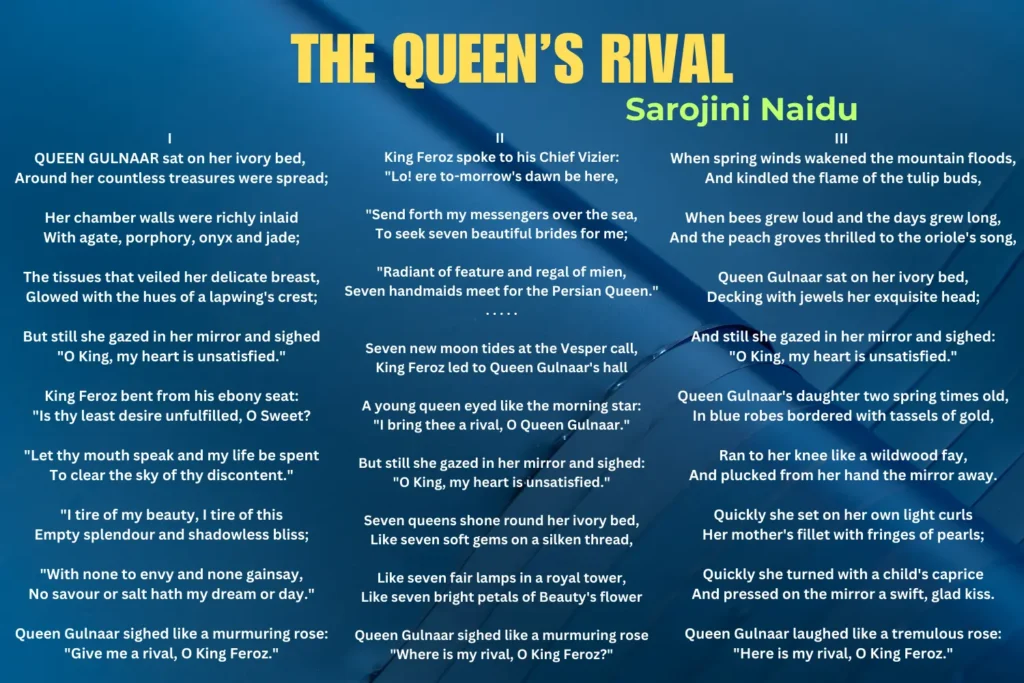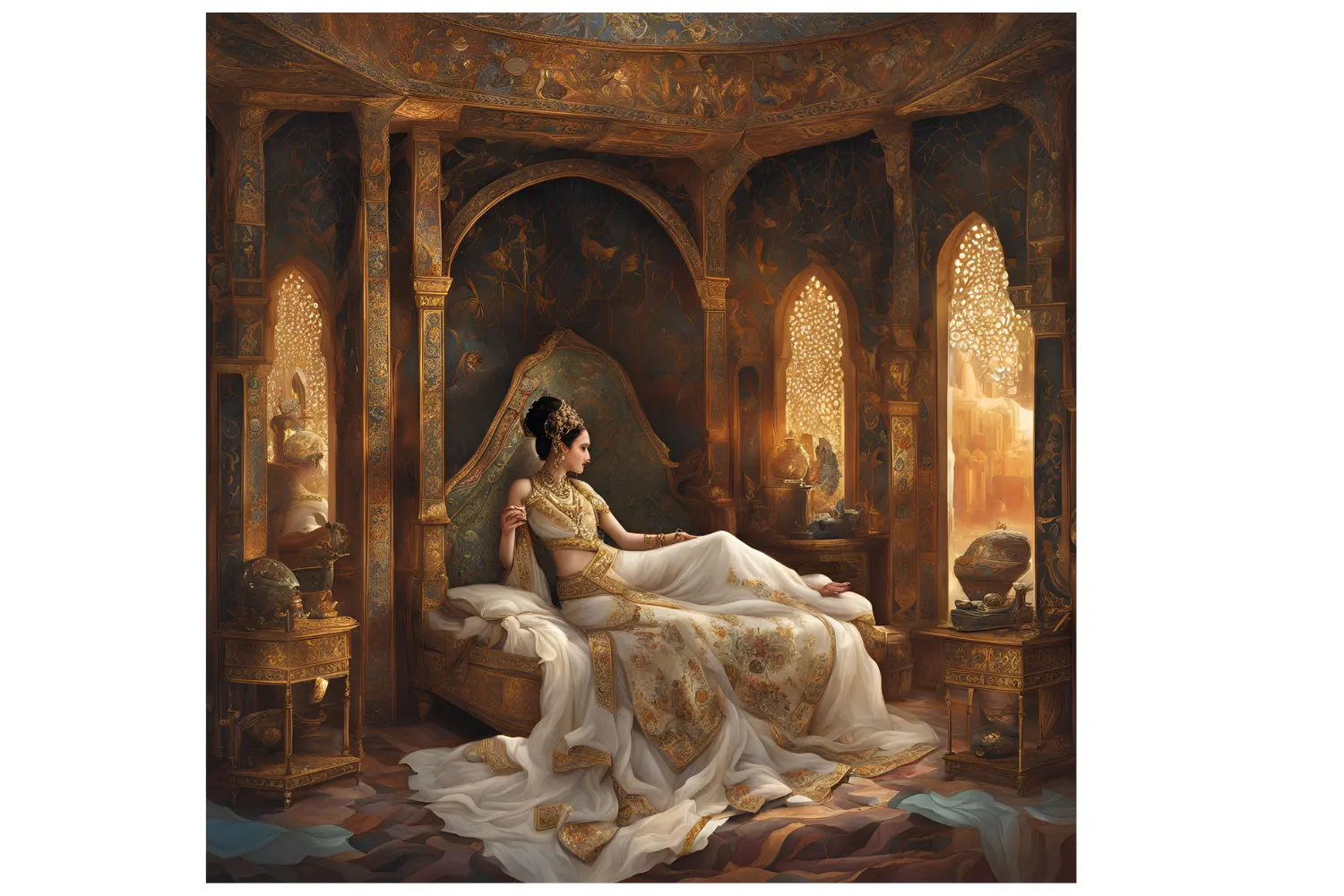Poem

About the Author
Brief Biography of Sarojini Naidu
Sarojini Naidu, often called the “Nightingale of India,” was a remarkable multifaceted personality who made significant contributions to Indian literature, politics, and the independence movement.
Early Life and Education
– Born on 13 February 1879 in Hyderabad, India
– Daughter of Aghorenath Chattopadhyay, a scientist and philosopher
– Demonstrated extraordinary intellectual abilities from a young age
– Learned multiple languages and showed poetic talents early in life
– Studied in England at King’s College, London, and Girton College, Cambridge
Literary Achievements
– Published her first collection of poems, “The Golden Threshold,” in 1905
– Wrote poetry in English, exploring themes of Indian culture, nationalism, and human emotions
– Known for her vivid imagery and lyrical quality
– Notable poetry collections include “The Bird of Time” and “The Broken Wing”
– Received praise from prominent poets like Laurence Hope and Arthur Symons
Political Career
– Became an active member of the Indian National Congress
– Worked closely with Mahatma Gandhi in the independence movement
– Participated in the Salt March and was imprisoned during the Civil Disobedience Movement
– First Indian woman to become the President of the Indian National Congress (1925)
– Served as the Governor of Uttar Pradesh after India’s independence (1947-1949)
Social Contributions
– Prominent feminist and advocate for women’s rights
– Worked towards social reform and women’s education
– Supported the cause of Indian independence through her writings and speeches
– Played a crucial role in bridging cultural and political divides
Personal Characteristics
– Known for her eloquence, wit, and passionate personality
– Fluent in multiple languages including English, Hindi, Urdu, and Bengali
– Respected as a poet, politician, and freedom fighter
Legacy
– Remembered as a national hero and important figure in India’s struggle for independence
– Celebrated for her contributions to literature and political activism
– Her birthday (13 February) is celebrated as Women’s Day in India
Death
– Passed away on 2 March 1949 in Lucknow, Uttar Pradesh
– Left behind a rich legacy of poetry, political activism, and social reform
Sarojini Naidu remains an iconic figure in Indian history, embodying the spirit of creativity, nationalism, and social progress during a transformative period in India’s journey towards independence.
Summary of the Poem
The poem The Queen’s Rival by Sarojini Naidu is a beautifully crafted narrative that explores themes of beauty, desire, and fulfillment through the perspective of Queen Gulnaar. The poem is divided into three parts, each revealing a different stage of the queen’s emotional journey.
In the first part, Queen Gulnaar sits in her luxurious chamber, surrounded by immense wealth and beauty, yet feeling deeply unsatisfied. Despite being adorned with magnificent treasures and wearing exquisite clothing, she tells King Feroz that she is weary of her empty splendor and wants something more. Interestingly, she asks the king to give her a rival, suggesting her profound boredom and desire for excitement or challenge.
The king responds by sending messengers to bring seven beautiful brides, hoping to satisfy the queen’s strange request. These seven new queens are described with poetic imagery – like “seven soft gems on a silken thread” or “seven bright petals of Beauty’s flower.” However, even with these new additions to the royal household, Queen Gulnaar remains unsatisfied, continuing to gaze in her mirror and sigh.
In the final part, during springtime, Queen Gulnaar is again seated on her ivory bed, adorning herself with jewels. This time, her two-year-old daughter enters the scene. The child playfully takes her mother’s mirror, puts on her mother’s pearl-fringed headdress, and kisses the mirror. This moment transforms the queen’s perception entirely. She suddenly realizes that her true “rival” is her daughter – a symbol of youth, potential, and the future.
The poem concludes with Queen Gulnaar laughing “like a tremulous rose” and declaring to King Feroz that she has found her rival in her child. This reveals the poem’s deeper message about motherhood, legacy, and finding meaning beyond personal beauty and material wealth.
Naidu’s use of rich, sensory language and her skillful progression of the queen’s emotional state make this poem a compelling exploration of a woman’s complex inner world, highlighting themes of beauty, desire, and the transformative power of motherhood.
Critical Appreciation of the Poem
Structural Analysis
The poem is structured in three parts, each with a distinct narrative progression:
- Part I introduces the queen's initial discontent
- Part II shows the king's attempt to fulfill her request
- Part III reveals the unexpected resolution
Themes
1. Existential Dissatisfaction
- Queen Gulnaar represents a sense of emptiness despite material abundance
- Her repeated phrase "my heart is unsatisfied" suggests a deeper spiritual or emotional hunger
- The poem explores the idea that external beauty and wealth cannot guarantee contentment
2. Motherhood and Legacy
- The turning point comes with the arrival of her daughter
- The child represents hope, renewal, and a continuation of life
- Motherhood is portrayed as the ultimate fulfillment that transcends personal vanity
3. Power Dynamics
- The poem subtly critiques patriarchal structures
- The king's literal interpretation of the queen's request (bringing seven brides)
- The queen ultimately finds power through her child, not through the king's actions
Poetic Techniques
- Imagery: Rich, sensory descriptions (ivory bed, jewels, "seven soft gems")
- Repetition: "Still she gazed in her mirror and sighed"
- Metaphorical Language: Comparisons like "sighed like a murmuring rose"
- Rhythmic Prose: Creates a lyrical, almost musical quality
Symbolism
- Mirror: Represents self-reflection, vanity, and inner searching
- Daughter: Symbolizes hope, future, and true personal legacy
- Seven Brides: Represent unsuccessful attempts to create meaning through external solutions
Psychological Depth
The poem explores complex female psychology:
- Initial restlessness and desire for stimulation
- Transformation through maternal love
- Rejection of superficial solutions to emotional emptiness
Cultural Context
- Reflects Persian or Indian royal traditions
- Explores feminine experience within traditional patriarchal structures
- Subtly challenges conventional notions of female fulfillment
Narrative Arc
The poem moves from:
- Discontent and boredom
- Artificial attempts at resolution
- To a profound, natural revelation of meaning through motherhood
Emotional Progression
- Opening: Restlessness and sighing
- Middle: Artificial attempts to create excitement
- Conclusion: Genuine joy and understanding through maternal connection
Literary Significance
Naidu masterfully uses poetry to:
- Critique societal expectations
- Explore inner feminine experiences
- Demonstrate that true fulfillment comes from within, not from external validation
The poem's beauty lies in its nuanced portrayal of a woman's journey from superficial desire to deep, meaningful understanding of her own identity and purpose.
Multiple Choice Questions
1. What does Queen Gulnaar desire?
a) the king’s attention
b) more jewellery
c) a rival
d) more clothes
2. What order does the king give the vizier?
a) to find expensive diamonds
b) to replace the queen
c) to find seven new brides
d) to kill the queen
3. What awakened the mountain floods?
a) rain
b) spring winds
c) the rivers
d) the monsoon
4. Who snatched the queen's mirror?
a) her daughter
b) the new bride
c) the king
d) none of the above
5. What does the child put on her head?
a) the queen’s crown
b) the queen’s headband
c) a tiara
d) the king’s crown
6. Who is the main female character in the poem?
a) Princess Amira
b) Queen Gulnaar
c) King Feroz’s daughter
d) The Chief Vizier’s wife
7. What does Queen Gulnaar repeatedly say she feels?
a) Angry
b) Jealous
c) Her heart is unsatisfied
d) Lonely
8. How many new brides did King Feroz bring to the palace?
a) Five
b) Six
c) Seven
d) Eight
9. What material is the queen's bed made of?
a) Gold
b) Silver
c) Marble
d) Ivory
10. How old is Queen Gulnaar's daughter in the poem?
a) One year old
b) Two spring times old
c) Three years old
d) Four years old
11. What does the daughter do that changes the queen's perspective?
a) Sang a song
b) Danced
c) Took the mirror and kissed it
d) Wore her mother’s jewels
12. How does the poem describe the seven new queens?
a) As seven thorns
b) As seven soft gems on a silken thread
c) As seven angry women
d) As seven sad brides
13. What does Queen Gulnaar initially request from King Feroz?
a) More jewels
b) A new palace
c) To have a rival
d) To travel
14. What metaphor is used to describe Queen Gulnaar's sigh in the poem?
a) Like a roaring lion
b) Like a murmuring rose
c) Like a thundering cloud
d) Like a weeping willow
15. What season is mentioned in the third part of the poem?
a) Autumn
b) Winter
c) Summer
d) Spring
Answer the questions briefly (30-40 words)
1. How does the poem explore the concept of existential dissatisfaction?
The poem portrays Queen Gulnaar’s deep emptiness despite material wealth and beauty. Her repeated statement that her heart is “unsatisfied” reveals her spiritual hunger, suggesting that external splendour cannot fulfil deeper emotional and psychological needs.
2. Analyze the significance of the mirror in the poem.
The mirror symbolizes self-reflection, vanity, and the queen’s search for meaning. It represents her initial focus on external beauty and her journey towards understanding true fulfilment through her child, transforming from a symbol of narcissism to self-discovery.
3. Discuss the role of motherhood in the poem's narrative.
Motherhood is presented as the ultimate source of meaning and fulfilment. The daughter becomes the queen’s “rival” by representing hope, renewal, and a deeper connection that transcends the superficial beauty and material wealth previously pursued.
4. How does the poem critique patriarchal structures?
The poem subtly challenges patriarchal expectations by showing the king’s literal and ineffective response to the queen’s emotional needs. The queen ultimately finds empowerment through her child, not through the king’s attempts to satisfy her desires.
5. Explain the symbolic transformation in the poem's final section.
The final section transforms the queen’s perception of a “rival” from an external, competitive concept to an internal, nurturing relationship. Her daughter’s playful interaction reveals a deeper understanding of fulfillment beyond physical beauty and social expectations.
- Why is the queen unsatisfied and seeks a rival?
- Describe the uniaque relationship between a mother and her daughter in the context of the poem.
References:
Board of editors. Literary Mindscapes I. Macmillan Publishers India Pvt. Ltd. Chennai, 2021.


1 thought on “The Queen’s Rival by Sarojini Naidu”